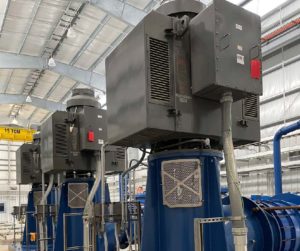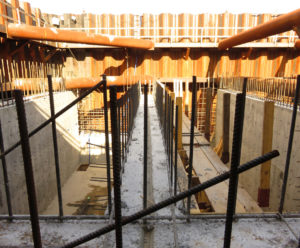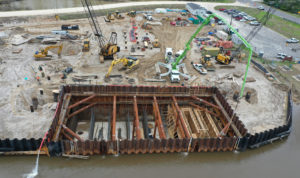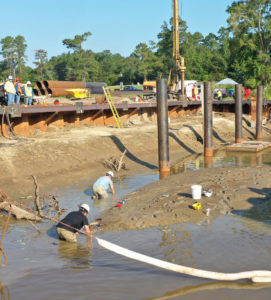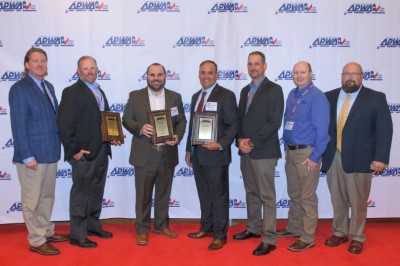Fast-Track Pump Station Project Provides Reliable Water Source During Droughts
The Sabine River Pump Station and Pipeline Project replaced an existing pump station that had reached the end of its design life. The project provides a more reliable water source during drought conditions as well as essential water supplies to serve industrial and municipal customers.
The project consisted of the following Sabine River Authority of Texas (SRA) facilities:
- A 285-MGD river intake on the Sabine River
- A raw water pump station with an initial firm capacity of 85 MGD and ultimate firm capacity of 285 MGD
- Seven miles of 66-inch pipeline from the pump station to the existing canal system
- An energy-dissipating structure at the connection to the canal and a check structure to control the canal water level to ensure delivery of water to both upstream and downstream customers
- Relocation of Camp House Road that ran through the pump station site
The team overcame regulatory challenges, severe weather events and construction complexities to successfully complete the project. Overall project efforts began with planning and preliminary design followed by a fast-track final design process using the Construction Manager at Risk (CMAR) delivery method that overlapped with procurement and construction, all to complete the project under budget to serve the East Texas Region.
Innovations of the Pump Station and Pipeline
As a result of extensive engineering and construction innovations, SRA has seen operational benefits in the pump station, as it can now access larger amounts of water at lower river elevations instead of increased releases from an upstream reservoir. Cost savings and schedule efficiency also resulted from competitive material bids and CMAR project delivery. Some of the innovative work includes:
- Sheet pile retaining walls tied back to deadmen pipe piles that allow the pump station structure to extend into the river for access to more water while also providing bank stabilization upstream and downstream of the intake.
- Sheet pile cofferdam structure braced with walers and pipe piles that allowed for construction of the pump station structure, which extended more than 10 feet below the bottom of the river. An extensive dewatering system included dewatering wells drilled in the middle of the river that minimized the inflow to the cofferdam.
- Specifying vertical line-shaft pumps with Variable Frequency Drives (VFDs) that allow for pump operation at all river elevations and provide efficient pumping across a wide range of system conditions.
- Enclosed line-shaft vertical pumps with a water lubrication system supplied by an on-site water well with a utility service backup will increase pump life by limiting the amount of suspended abrasives in contact with the shaft and bearings.
- A Supervisory Control and Data Acquisition (SCADA) system can automatically run the pump station based on canal levels and adjust the number of pumps running and pump speeds based on river levels, canal levels and maintaining a target level at the canal. This innovative system requires minimal oversight and yields efficiency for SRA. As a result, SRA is working on an areawide monitoring system for their existing canal system.
- A check structure maintains upstream water surface elevations for customer intakes and has operable gates that will automatically open to allow downstream flow based on downstream canal levels.
- Utilizing fiberglass casing pipe for tunnels allowed for cost savings, electrical isolation and corrosion resistance.
- Competitive Sealed Proposals allowed the SRA, engineer and contractor to select the best pipe material for the project. The team weighed the decision of pipe material based on soil conditions, bedding material/compaction and welding requirements to pick the best value. In the end, prestressed concrete cylinder pipe was selected for cost effectiveness in the installation process.
- Value Engineering (VE) maximized SRA’s project budget and delivered cost savings. CMAR project delivery allowed the project team to VE the project in real time and make decisions based on actual construction costs.
Value Engineering and Construction Complexities
The SRA received a $75 million SWIFT loan from the TWDB for the entire project, which was based on the budget prepared during the project’s conceptual design phase. As design progressed, the team made important decisions on how to provide a high-quality product without exceeding the project budget. As part of this effort, the project team (Freese and Nichols as Design Consultant and Garney as Construction Manager) provided alternatives to save money where possible, especially during procurement of performance contracts. VE was a critical element for the team to determine the most cost-effective design and provide funds for “wish list” items such as a third pump and its associated piping, valves and electrical equipment, bypass piping under the canal, and concrete and asphalt site paving.
Value Engineering ideas incorporated in the project included:
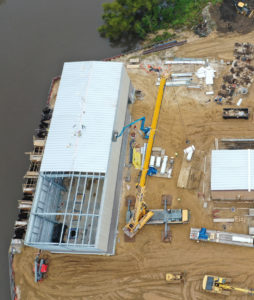
- Installation savings through the use of prestressed concrete cylinder pipe
- SRA-constructed bypass canal
- Utilization of pipeline haul-off material for pump station site fill
- Allowances for alternate pipeline embedment materials and tunnel liner materials
- Reduction in generator size
- Construction of a detached electrical building to reduce the amount of permanent sheet piling
Construction Complexities
Early procurement of construction packages combined with challenging site conditions created complexities during construction. Because design was not finalized prior to bidding, design changes that occurred after bidding had to be properly communicated to the contractor. Examples include changes as small as moving a 1-inch ball valve and as large as correcting the coordinates of a structure.
Early on, site conditions for both the pump station and pipeline made construction difficult, and groundwater, rainwater and river water needed to be addressed. Pipeline construction relied on berms and ditches for routing surface water and dewatering wells for preventing groundwater intrusion into the trench, while pump station construction focused on providing a water-tight cofferdam and dewatering wells to isolate excavation from the river and groundwater to keep the excavation dry.
Installing the sheet pile cofferdam was a significant challenge due to higher-than-normal river levels at the beginning of construction that lasted several months. Higher flows increased river velocities, slowed cofferdam progress, and brought debris and damage to an uncompleted section when a tree hit the sheet pile, requiring reinstallation.
The sheet pile cofferdam was designed for a 50-year flood elevation to accommodate construction through high river conditions and successfully reduce the risk of overtopping the shoring system that could have led to costly project delays. Due to the large size of sheets, the contractor developed an alternative to shipping materials by barge. In order to achieve the required height for flood protection, the contractor first installed a traditional sheet pile approximately 55 feet long and then welded additional length.
Tracking the river level was crucial to safely completing construction and tracking progress throughout cofferdam construction, excavation for the structure, and concrete placements for the wet well. The contractor identified construction to be completed during drops in the river
level, such as waler and tie-rod installation, and adjusted construction sequencing accordingly. Tracking the river level was also crucial for pipeline construction; the contractor started in the middle of the route heading east but quickly moved work to the section near the pump station and river when the river level dropped, allowing for “dry” construction through a slough and set of oxbows connected to the Sabine River.
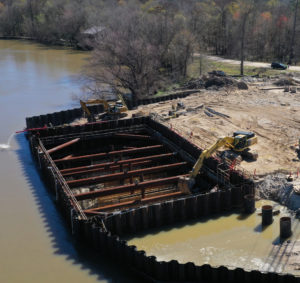
Implementation of a Safety Program During Construction
Garney Companies, Inc., the CMAR selected for the project, implemented an extensive safety program that led to project completion with zero accidents. Staff members on-site included 22 subcontractors, 10 equipment representatives, along with SRA, engineering and CMAR staff. In total, construction included approximately 420,000 man-hours completed in the field by various contractors and 5,000 inspection hours provided by the engineer and SRA.
Safety discussions began during pre-construction and took place regularly during planning and scheduling meetings. In addition, safety was a crucial element of daily task planning and essentially became a part of every aspect in the construction process.
During CMAR evaluations, safety records and history were used by SRA and the engineer as part of the CMAR selection. An important aspect was the prospective CMAR’s staff. For the Sabine River Pump Station project, Garney assigned an On-site Safety Manager who was supported by the Corporate Regional Safety Manager. This attention to safety was utilized during selection of every bid package for subcontractors and suppliers.
The main aspects of the project’s safety program included the following:
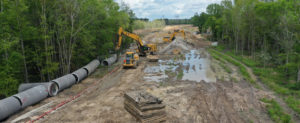 Job-site orientation (general site-specific safety items) for all project staff
Job-site orientation (general site-specific safety items) for all project staff- Subcontractor safety outreach program
- COVID-19 safety practices
- Monthly jobsite safety meetings
- Biweekly safety audits performed by the job-site safety team
- Weekly toolbox safety meetings
- Individual meetings for sharing Garney safety materials with subcontractors held by On-site CMAR Safety Manager
- Daily safety briefings with staff conducted by the On-site Safety Manager
- Daily Safety Task Awareness Cards utilized by construction teams
- Additional, periodic safety inspections implemented by SRA’s Safety Manager and the CMAR’s Regional Safety Manager
- Safety awards program for special project milestones
- A jobsite safety plan that included Personal Protection Equipment (PPE) and drug enforcement policies
- Quarterly Safety Shutdowns on Garney self-performed portions of the project included safety training and other construction techniques
Environmental Plan Includes Extensive Coordination and Permitting to Protect Wildlife
SRA and the project team worked closely with the Texas Parks & Wildlife Department (TPWD) to develop a plan for minimizing environmental impacts in the 128-acre project area. This included accommodations for land and aquatic life with the following measures in accordance with environmental regulatory requirements:
Nest Surveys
To ensure that birds were not impacted along the pipeline right-of-way, the team completed nest surveys of the project site and pipeline easement prior to clearing the project area, paying close attention to spot migratory birds and bald eagles. These efforts were in compliance with the Bald and Golden Eagle Protection Act and Migratory Bird Treaty Act.
As a result, construction clearings took place outside the migratory bird nesting season. When clearing was completed during the nesting season, crews established appropriate buffers around any observed active nests.
Aquatic Resource Recovery Plan (ARRP)
SRA developed an ARRP that addressed recovery and relocation of native fish and mussels behind the cofferdam in the Sabine River and Gulf Coast Canal as well as within the pipeline oxbow crossings. The plan aimed to control and limit the impacts of dewatering, maintenance or construction.
As part of the plan, SRA and the design consultant performed a mussel survey and relocated mussels approximately 1,100 feet upstream from the pump station site along the west bank of the river. These efforts were in compliance with the Aquatic Resources State Law.
The team also surveyed and provided further protection measures for state-listed species, including the Rafinesque’s big-eared bat, alligator snapping turtles and common snapping turtles, northern scarlet snakes, and timber rattlesnakes.
Cultural Resources Investigation
Completed for the entire 128-acre project area, the resulting report confirmed no significant findings by the THC and USACE.
Construction Measures
The team installed sediment control fencing and implemented erosion control measures through the use of no-till drilling, hydromulching and/or hydroseeding.
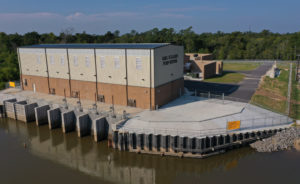 The multiphase engineering and construction effort included:
The multiphase engineering and construction effort included:
- Funding applications
- Pipeline route study and alignment
- Pump station analysis to determine the best type of pump and capacity for meeting variable water demands
- Preliminary and final design
- Environmental permitting and protection
- Hydraulic analysis of the Sabine River
- Water quality sampling and analysis
- 1D and 2D Computational Fluid Dynamic (CFD) modeling of approximately 8 miles of the river
- Physical modeling of the river to further analyze hydraulics of various pump station components and evaluate sediment transport
- Geotechnical engineering
- Fluvial geomorphological analysis of the river
- Coordination with TCEQ on raw water intake regulations and 316b requirements
- Coordination with USACE on environmental permitting for the project and required mitigation
- Construction Phase Services (Resident Project Representative) that included on-site management and inspection
